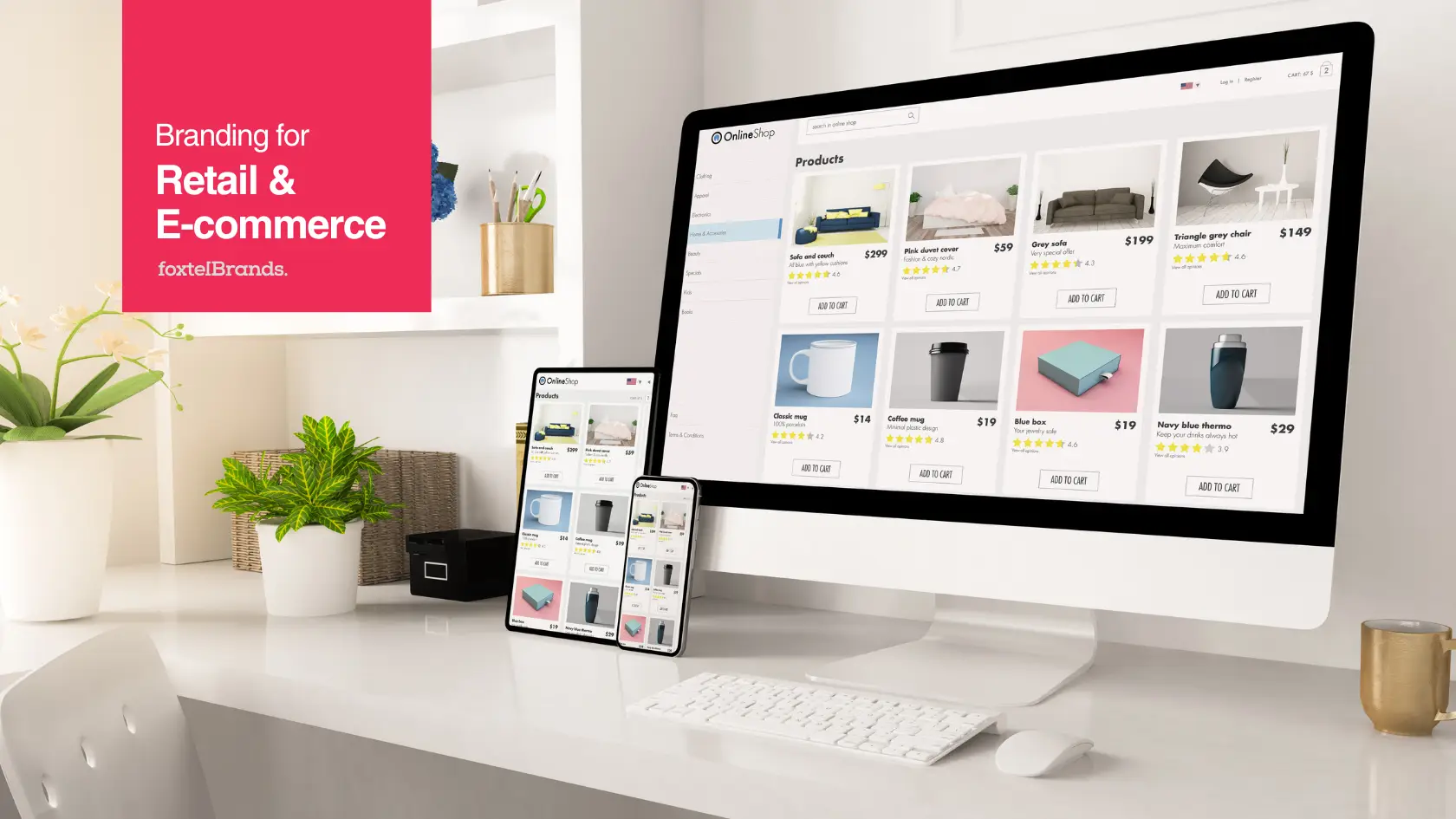The eCommerce industry is rapidly expanding, with new platforms and technologies continuously emerging. This sector includes a wide range of products and services, from fashion and beauty to electronics and home goods. Creating a strong eCommerce brand that conveys trust, quality, and customer satisfaction is essential for standing out in a crowded market.
To achieve this, eCommerce businesses must address several challenges, such as building and maintaining trust, ensuring consistent messaging across platforms, boosting brand awareness, creating a seamless shopping experience, staying relevant in a constantly changing industry, and developing a recognizable visual identity.
By overcoming these challenges, businesses can create a memorable brand that resonates with customers and drives sales.
Essential Branding Elements for Retail & E-commerce:
Brand Strategy: Laying the Groundwork for Success
Why It’s Needed: A brand strategy aligns your business goals with your brand identity. It ensures that every aspect of your eCommerce brand, from visuals to messaging, reflects your core values and resonates with your target audience. A well-defined brand strategy serves as the foundation for all branding efforts and helps maintain consistency.
Logo Design
Why It’s Needed: Your logo is the visual anchor of your brand. It’s the first thing people notice and remember about your business. A unique and memorable logo helps establish your brand identity and sets you apart from competitors.
Website Design
Why It’s Needed: Your website serves as the online face of your brand and is a crucial touchpoint for customers. A professional, user-friendly, and responsive website enhances the user experience and ensures accessibility across different devices. It helps build trust and credibility while providing essential information about your products and services.
App Interface Design
Why It’s Needed: Mobile apps enhance the shopping experience by providing convenient access to your store and products. An intuitive and visually appealing app interface keeps users engaged, facilitates communication, and supports seamless interactions.
Product Packaging
Why It’s Needed: Creating attractive and functional packaging enhances the unboxing experience. Packaging is a key touchpoint that reinforces your eCommerce brand and enhances the customer experience.
Delivery Experience
Why It’s Needed: Crafting a seamless and memorable delivery experience enhances customer satisfaction and builds loyalty. Branded packaging and personalized touches can make a significant impact on the overall perception of your brand.
Digital Marketing Materials
Why It’s Needed: Engaging social media graphics, email templates, and online ads are essential for promoting your eCommerce brand effectively. A consistent digital presence boosts brand visibility and helps attract new customers.
Marketing Collateral
Why It’s Needed: Brochures, business cards, flyers, and posters convey essential information and reinforce your brand identity. Physical materials help strengthen your brand presence and ensure that your brand is remembered by customers.
Brand Merchandise
Why It’s Needed: Branded t-shirts, mugs, and other merchandise boost brand visibility and loyalty. Merchandise helps build brand recognition and creates a sense of connection with your customers.
Expected Deliverables from Designers
Designer Deliverables: Designers should provide the following comprehensive and realistic deliverables to ensure your eCommerce brand is cohesive and impactful:
Brand Strategy Document:
Mission statement: Clearly defines the purpose of your eCommerce business.
Vision statement: Outlines the long-term goals and aspirations.
Core values: Identifies the fundamental beliefs that guide your brand.
Target audience analysis: In-depth research on the demographics, preferences, and behaviors of your target customers.
Unique Selling Points (USPs): Highlights what sets your brand apart from competitors.
Brand positioning and messaging: Develops a clear and consistent brand voice that resonates with your audience.
Logo Design:
Initial sketches and concept development: Several design concepts based on the brand strategy.
Design brief: Document detailing style, colors, and themes.
Final logo in various formats: Provided in high-resolution (JPEG, PNG, SVG, EPS) for versatility.
Horizontal and vertical logo variations: Different orientations for flexible use.
Logo usage guidelines: Ensures consistent application across all materials.
Brand Guidelines:
Color palette and codes: Specific colors and their codes for print and digital use.
Typography and font usage: Defines primary and secondary fonts.
Logo usage and placement: Guidelines for correct logo usage.
Imagery and photography style: Visual style that reflects the brand identity.
Tone of voice and messaging: Consistent language and tone across all communications.
Do’s and Don’ts of brand usage: Clear rules for maintaining brand integrity.
Website Design:
Sitemap and wireframes: Blueprint of the website’s structure.
High-fidelity mockups: Detailed design of the website’s look and feel.
User Interface (UI) design: Visual elements and interactive features.
User Experience (UX) design: Ensures an intuitive and seamless user journey.
Responsive design for various devices: Compatibility across desktops, tablets, and smartphones.
Development-ready files: HTML, CSS, and JavaScript files for seamless handoff to developers.
Content Management System (CMS) integration: Easy content updates and management.
App Interface Design:
User flow diagrams: Maps out the customer journey within the app.
Wireframes for key screens: Outlines the app’s structure.
Interactive prototypes: Testable models for user feedback.
High-fidelity mockups: Final design showcasing the app’s look and feel.
User testing feedback: Insights to refine the design.
Final design files: Ready for development handoff.
Product Packaging:
Design concepts: Creative ideas that reflect the brand identity.
Material selection: Sustainable and functional packaging materials.
Functional design: Ensures protection and appeal of products.
Delivery Experience:
Branded packaging: Customized boxes, bags, and inserts with logo and brand colors.
Tracking and communication: Branded emails and SMS notifications.
Personalized touches: Thank you notes, discount codes, and personalized messages.
Digital Marketing Materials:
Social media templates: Customizable designs for various platforms.
Email newsletter templates: Branded designs for email campaigns.
Online ad banners: Static and animated ads for digital advertising.
Blog post graphics: Visuals for engaging blog content.
Infographics and data visualizations: Informative and visually appealing graphics.
Marketing Collateral:
Business cards: Professional and memorable designs.
Brochures: Informative and visually appealing designs.
Flyers and posters: Eye-catching promotional materials.
Presentation templates: Branded PowerPoint and Keynote templates.
Event and trade show materials: Booth designs, banners, and promotional items.
Brand Merchandise:
T-shirt designs: Creative and wearable designs.
Mug designs: Branded mugs for promotional giveaways.
Tote bags: Functional and branded bags.
Stationery items: Notebooks, pens, and other branded stationery.
Custom promotional items: Stress balls, water bottles, and other unique items.
Physical Store Design (if applicable):
Store layout and interior design: Ensures a cohesive brand experience in physical stores.
Signage and displays: Branded signs and product displays.
Point-of-sale materials: Branded POS systems and promotional items.
Customer experience design: Enhances the in-store experience through branded elements.
Human-Centric and Accessibility-Focused Elements:
Importance: Accessibility ensures that all users, including those with disabilities, can interact with your brand.
Inclusive Design Tips: Use high contrast colors, readable fonts, and provide alternative text for images to enhance accessibility.
Examples: eCommerce brands like Amazon and Etsy that prioritize accessibility.
Case Study:
Glossier: A Beauty Brand’s Journey to E-commerce Success
Before the Rebrand: When Glossier first launched, it was a beauty blog known as “Into The Gloss.” The transition from a blog to a full-fledged beauty brand required a cohesive brand identity that would appeal to a broader audience.
The Rebranding Process: Glossier focused on creating a user-friendly, visually appealing e-commerce platform that stood out in the crowded beauty market. The company’s branding efforts emphasized simplicity, authenticity, and community engagement.
Key Branding Elements:
Logo Design: Glossier’s logo features a sleek, modern design that is easily recognizable and reflects the brand’s minimalist aesthetic.
Website Design: The e-commerce website is clean, intuitive, and easy to navigate, highlighting Glossier’s products and user-generated content.
App Interface Design: The app’s user interface is designed to provide a seamless shopping experience, with high-quality product images and easy checkout.
Product Packaging: Glossier developed attractive, functional packaging that enhances the unboxing experience and reinforces brand identity.
Delivery Experience: Glossier ensured a seamless delivery experience with branded packaging, real-time tracking, and personalized touches like thank-you notes.
Marketing Collateral: Glossier created engaging brochures, business cards, and posters to promote their brand.
Brand Merchandise: Glossier produced branded merchandise, such as tote bags and stickers, to build brand loyalty.
Human-Centric and Accessibility-Focused Elements: Glossier prioritized accessibility by ensuring that their website and app were usable by people with disabilities, incorporating features like screen reader compatibility and keyboard navigation.
Results: After the rebrand, Glossier saw a significant increase in user engagement and sales. The new branding helped position Glossier as a leading beauty brand in the e-commerce space, quickly gaining a loyal customer base.
Conclusion:
Branding is a vital component of success for eCommerce businesses. By focusing on key branding elements and ensuring accessibility, you can create a strong, memorable eCommerce brand identity. If you have any questions or need further assistance, feel free to reach out
Talk to us
Enhance Your Retail & E-commerce Brand with FoxtelBrands
Ready to take your retail or e-commerce brand to the next level? At FoxtelBrands, we specialize in crafting compelling brand identities that drive customer engagement and loyalty. Whether you’re launching a new online store, rebranding an existing business, or enhancing your physical retail presence, our expert team is here to help you create a unique and memorable brand experience, contact us at foxtelBrands.
We’re here to help you every step of the way!


